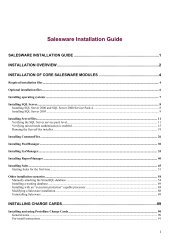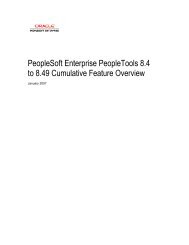Cognos ReportNetTM Installation and Configuration Guide
Cognos ReportNetTM Installation and Configuration Guide
Cognos ReportNetTM Installation and Configuration Guide
You also want an ePaper? Increase the reach of your titles
YUMPU automatically turns print PDFs into web optimized ePapers that Google loves.
Chapter 7: Advanced <strong>Configuration</strong> Options<br />
Advanced configuration options are changes that you make after installation to the configuration<br />
properties of the resources that ReportNet components use.You cannot use <strong>Cognos</strong><br />
<strong>Configuration</strong> to make these changes. Advanced configuration options enhance security,<br />
improve performance, or change the default behavior of ReportNet.<br />
Change the JVM Used by ReportNet<br />
To better suit your reporting environment, you can change which Java Virtual Machine (JVM)<br />
ReportNet uses, using the following criteria:<br />
• Java HotSpot Client VM<br />
Use this JVM for proof of concept, demonstration, or development environments. This JVM<br />
is specially tuned to reduce both the startup time for applications <strong>and</strong> the memory footprint.<br />
This is the default setting for ReportNet installation on Windows. On UNIX platforms,<br />
<strong>Cognos</strong> does not provide a Java Runtime Environment (JRE). Therefore, the default JVM<br />
that ReportNet uses depends on the current setting in your existing JRE.<br />
• Java HotSpot Server VM<br />
Use this JVM for long-running server applications to maximize operating speeds when<br />
performance is more important than fast startup time.<br />
• Classic VM<br />
For compatibility reasons, you may have to use the Classic VM. Not all Java Development<br />
Kits (JDKs) have a Classic VM. In UNIX, if you are using JavaSoft Solaris JDK 1.3 or any of<br />
the JavaSoft 1.4 JDKs, you have only the HotSpot VM.<br />
For more information, see the Sun Microsystems Inc. Web site.<br />
Because all application servers, such as Tomcat, WebLogic, <strong>and</strong> WebSphere, require a JVM to<br />
run, you must already have one installed.<br />
Steps<br />
1. Go to the location where your Java Runtime Environment (JRE) libraries are installed:<br />
• In Windows, go to crn_location\bin\jre\1.3.1\lib.<br />
• In UNIX, go to JAVA_HOME/jre/lib.<br />
2. Open jvm.cfg in an editor.<br />
3. Ensure that the JVM that you want to use is the first uncommented line. Enter the<br />
appropriate text for the JVM you want to use:<br />
JVM<br />
Hotspot Client<br />
Hotspot Client<br />
Classic<br />
Text<br />
hotspot<br />
server<br />
classic<br />
4. Save <strong>and</strong> close the file.<br />
<strong>Installation</strong> <strong>and</strong> <strong>Configuration</strong> <strong>Guide</strong> 77
















